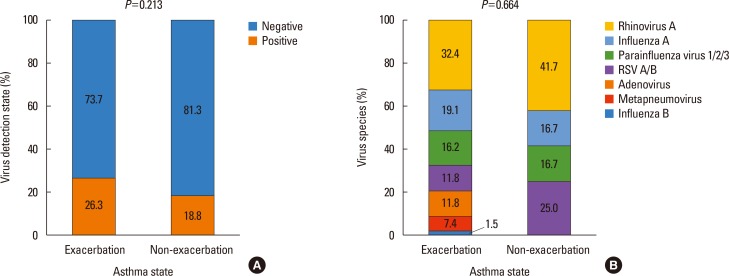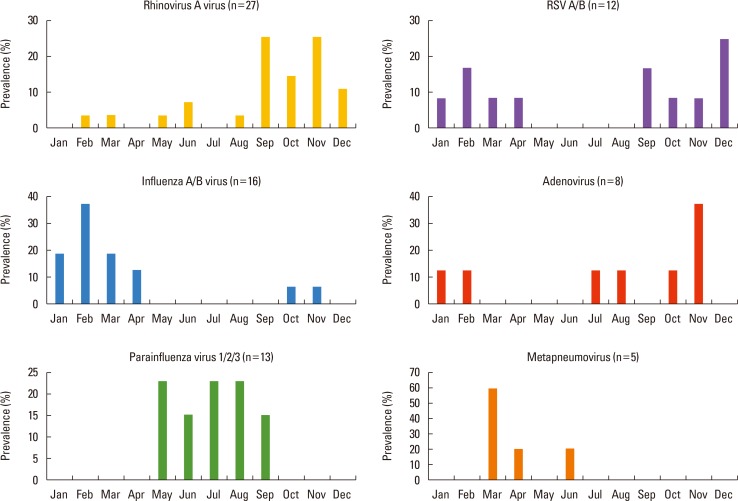Allergy Asthma Immunol Res.
2017 Nov;9(6):491-498. 10.4168/aair.2017.9.6.491.
Prevalence of Respiratory Viral Infections in Korean Adult Asthmatics With Acute Exacerbations: Comparison With Those With Stable State
- Affiliations
-
- 1Division of Allergy and Respiratory Disease, Soonchunhyang University Cheonan Hospital, Cheonan, Korea.
- 2Department of Interdisciplinary Program in Biomedical Science Major Graduate School of Soonchunhyang University, Asan, Korea.
- 3Genome Research Center and Division of Allergy and Respiratory Disease, Soonchunhyang University Bucheon Hospital, Bucheon, Korea.
- 4Division of Allergy and Respiratory Disease, Department of Internal Medicine, Soonchunhyang University Bucheon Hospital, Bucheon, Korea. mcspark@daum.net
- 5Division of Allergy and Respiratory Disease, Soonchunhyang University Gumi Hospital, Gumi, Korea.
- 6College of Korean Medicine, Sangji University, Wonju, Korea.
- KMID: 2421659
- DOI: http://doi.org/10.4168/aair.2017.9.6.491
Abstract
- PURPOSE
Viral infections are involved in ~50% of exacerbations among Caucasian adult asthmatics. However, there have been few reports on the causative virus of exacerbations in Korean adult asthmatics. Thus, we compared frequencies and types of viruses between lower respiratory tract illnesses (LRTIs) with exacerbations (exacerbated LRTIs) and those without exacerbations (stable LRTIs) to evaluate contribution of respiratory viruses to exacerbations.
METHODS
Viral RNA was extracted from sputum using the Viral Gene-spinâ„¢ Kit. Reverse transcription-polymerase chain reaction (RT-PCR) was performed to detect adenovirus (ADV), metapneumovirus (MPV), parainfluenza virus (PIV) 1/2/3, influenza virus (IFV) A, IFV B, respiratory syncytial virus (RSV) A/B, and rhinovirus (RV) A.
RESULTS
Among the 259 patients, 210 underwent a single sputum examination, and the remaining 49 underwent 2 to 4 sputum examinations. Virus was detected in 68 of the 259 exacerbated episodes and in 11 of the 64 stable episodes. Among the exacerbated episodes, RV was the most frequently detected virus, followed by influenza A, parainfluenza, RSV A/B, and ADV. Among the 11 stable episodes, RV was most frequently detected. Detection rates of these viruses did not differ between the 2 groups (P>0.05). Thirty-five patients underwent the virus examination at 2 episodes of exacerbation, while 14 patients underwent at each time of exacerbated and stable episodes. Virus detection rate at the second examination was significantly higher in cases with 2 exacerbation episodes than in those with initial exacerbation and sequential stable episodes (P=0.003). A seasonal pattern was noted in the detection rates of RV (September to December), IFV (January to April), PIV (May to September), and RSV A/B (September to April).
CONCLUSIONS
Respiratory viruses were identified in approximately 20% of LRTI irrespective of the presence of asthma exacerbation. RV and IFV A/B were most frequently detected. A group of patients experienced frequent viral infections followed by asthma exacerbations.
Keyword
MeSH Terms
Figure
Reference
-
1. Masoli M, Fabian D, Holt S, Beasley R. Global Initiative for Asthma (GINA) Program. The global burden of asthma: executive summary of the GINA Dissemination Committee report. Allergy. 2004; 59:469–478. PMID: 15080825.
Article2. Dougherty RH, Fahy JV. Acute exacerbations of asthma: epidemiology, biology and the exacerbation-prone phenotype. Clin Exp Allergy. 2009; 39:193–202. PMID: 19187331.
Article3. Murray CS, Simpson A, Custovic A. Allergens, viruses, and asthma exacerbations. Proc Am Thorac Soc. 2004; 1:99–104. PMID: 16113420.
Article4. Tan WC. Viruses in asthma exacerbations. Curr Opin Pulm Med. 2005; 11:21–26. PMID: 15591884.
Article5. Olenec JP, Kim WK, Lee WM, Vang F, Pappas TE, Salazar LE, et al. Weekly monitoring of children with asthma for infections and illness during common cold seasons. J Allergy Clin Immunol. 2010; 125:1001–1006.e1. PMID: 20392488.
Article6. Johnston SL, Pattemore PK, Sanderson G, Smith S, Lampe F, Josephs L, et al. Community study of role of viral infections in exacerbations of asthma in 9–11 year old children. BMJ. 1995; 310:1225–1229. PMID: 7767192.7. Beasley R, Coleman ED, Hermon Y, Holst PE, O'Donnell TV, Tobias M. Viral respiratory tract infection and exacerbations of asthma in adult patients. Thorax. 1988; 43:679–683. PMID: 3194873.
Article8. Nicholson KG, Kent J, Ireland DC. Respiratory viruses and exacerbations of asthma in adults. BMJ. 1993; 307:982–986. PMID: 8241910.
Article9. Corne JM, Marshall C, Smith S, Schreiber J, Sanderson G, Holgate ST, et al. Frequency, severity, and duration of rhinovirus infections in asthmatic and non-asthmatic individuals: a longitudinal cohort study. Lancet. 2002; 359:831–834. PMID: 11897281.
Article10. Atmar RL, Guy E, Guntupalli KK, Zimmerman JL, Bandi VD, Baxter BD, et al. Respiratory tract viral infections in inner-city asthmatic adults. Arch Intern Med. 1998; 158:2453–2459. PMID: 9855383.
Article11. Sokhandan M, McFadden ER Jr, Huang YT, Mazanec MB. The contribution of respiratory viruses to severe exacerbations of asthma in adults. Chest. 1995; 107:1570–1574. PMID: 7781348.
Article12. Teichtahl H, Buckmaster N, Pertnikovs E. The incidence of respiratory tract infection in adults requiring hospitalization for asthma. Chest. 1997; 112:591–596. PMID: 9315789.
Article13. Tregoning JS, Schwarze J. Respiratory viral infections in infants: causes, clinical symptoms, virology, and immunology. Clin Microbiol Rev. 2010; 23:74–98. PMID: 20065326.
Article14. Friedlander SL, Busse WW. The role of rhinovirus in asthma exacerbations. J Allergy Clin Immunol. 2005; 116:267–273. PMID: 16083778.
Article15. Choi EH, Lee HJ, Kim SJ, Eun BW, Kim NH, Lee JA, et al. The association of newly identified respiratory viruses with lower respiratory tract infections in Korean children, 2000–2005. Clin Infect Dis. 2006; 43:585–592. PMID: 16886150.
Article16. Kim WK, Gern JE. Updates in the relationship between human rhinovirus and asthma. Allergy Asthma Immunol Res. 2012; 4:116–121. PMID: 22548203.
Article17. Kim TB, Jang AS, Kwon HS, Park JS, Chang YS, Cho SH, et al. Identification of asthma clusters in two independent Korean adult asthma cohorts. Eur Respir J. 2013; 41:1308–1314. PMID: 23060627.
Article18. Park SW, Kim DJ, Chang HS, Park SJ, Lee YM, Park JS, et al. Association of interleukin-5 and eotaxin with acute exacerbation of asthma. Int Arch Allergy Immunol. 2003; 131:283–290. PMID: 12915771.
Article19. Park SW, Lee YM, Jang AS, Lee JH, Hwangbo Y, Kim DJ, et al. Development of chronic airway obstruction in patients with eosinophilic bronchitis: a prospective follow-up study. Chest. 2004; 125:1998–2004. PMID: 15189914.20. Horn ME, Brain EA, Gregg I, Inglis JM, Yealland SJ, Taylor P. Respiratory viral infection and wheezy bronchitis in childhood. Thorax. 1979; 34:23–28. PMID: 220747.
Article21. Minor TE, Dick EC, Baker JW, Ouellette JJ, Cohen M, Reed CE. Rhinovirus and influenza type A infections as precipitants of asthma. Am Rev Respir Dis. 1976; 113:149–153. PMID: 174464.22. Kwon JM, Shim JW, Kim DS, Jung HL, Park MS, Shim JY. Prevalence of respiratory viral infection in children hospitalized for acute lower respiratory tract diseases, and association of rhinovirus and influenza virus with asthma exacerbations. Korean J Pediatr. 2014; 57:29–34. PMID: 24578714.
Article23. Park JS, Kim JN, Kim MS, Seo KH, Uh ST, Kim YH, et al. Comparison of virus detected in sputum and nasal washing fluids from exacerbated asthmatics. In : Proceedings of the 2016 KAAACI Annual Spring Congress; 2016 May 6–7; Seoul. Seoul: Korean Academy of Asthma, Allergy and Clinical Immunology;2016. p. 185.24. Douglas RG Jr, Cate TR, Gerone PJ, Couch RB. Quantitative rhinovirus shedding patterns in volunteers. Am Rev Respir Dis. 1966; 94:159–167. PMID: 4288100.25. Harris JM 2nd, Gwaltney JM Jr. Incubation periods of experimental rhinovirus infection and illness. Clin Infect Dis. 1996; 23:1287–1290. PMID: 8953073.
Article26. Grünberg K, Timmers MC, de Klerk EP, Dick EC, Sterk PJ. Experimental rhinovirus 16 infection causes variable airway obstruction in subjects with atopic asthma. Am J Respir Crit Care Med. 1999; 160:1375–1380. PMID: 10508832.
Article27. Green RM, Custovic A, Sanderson G, Hunter J, Johnston SL, Woodcock A. Synergism between allergens and viruses and risk of hospital admission with asthma: case-control study. BMJ. 2002; 324:763. PMID: 11923159.
Article28. Weiss ST, Utell MJ, Samet JM. Environmental tobacco smoke exposure and asthma in adults. Environ Health Perspect. 1999; 107(Suppl 6):891–895. PMID: 10592149.
Article29. Sunyer J, Spix C, Quénel P, Ponce-de-León A, Pönka A, Barumandzadeh T, et al. Urban air pollution and emergency admissions for asthma in four European cities: the APHEA Project. Thorax. 1997; 52:760–765. PMID: 9371204.
Article30. Goldsmith CA, Kobzik L. Particulate air pollution and asthma: a review of epidemiological and biological studies. Rev Environ Health. 1999; 14:121–134. PMID: 10674285.
Article31. Lim JS, Woo SI, Kwon HI, Baek YH, Choi YK, Hahn YS. Clinical characteristics of acute lower respiratory tract infections due to 13 respiratory viruses detected by multiplex PCR in children. Korean J Pediatr. 2010; 53:373–379.
Article32. Griswold SK, Nordstrom CR, Clark S, Gaeta TJ, Price ML, Camargo CA Jr. Asthma exacerbations in North American adults: who are the “frequent fliers” in the emergency department? Chest. 2005; 127:1579–1586. PMID: 15888831.33. Rodrigo GJ, Rodrigo C, Hall JB. Acute asthma in adults: a review. Chest. 2004; 125:1081–1102. PMID: 15006973.
- Full Text Links
- Actions
-
Cited
- CITED
-
- Close
- Share
- Similar articles
-
- Respiratory Viruses in Acute Exacerbations of Bronchiectasis
- Seasonality of asthma exacerbation in children caused by respiratory virus infection and allergen sensitization
- Prevalence of respiratory viral infection in children hospitalized for acute lower respiratory tract diseases, and association of rhinovirus and influenza virus with asthma exacerbations
- The Relationship between Airway Inflammation and Exacerbation in Chronic Obstructive Pulmonary Disease
- Expression of glucocorticoid receptor beta in peripheral blood mononuclear cells of asthmatics experiencing exacerbation after upper respiratory infection



